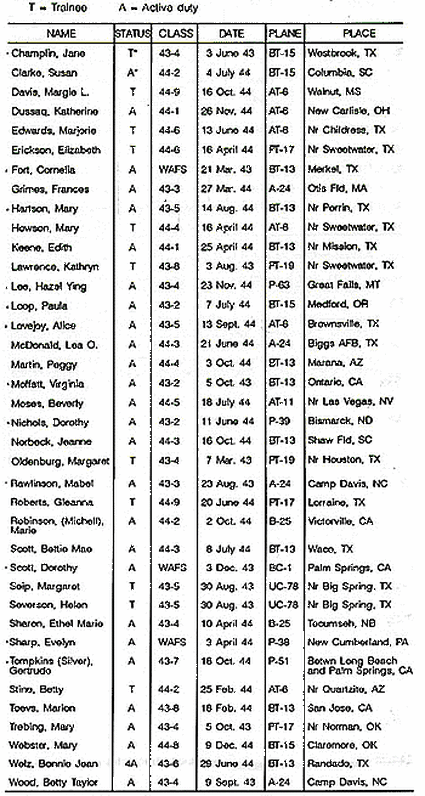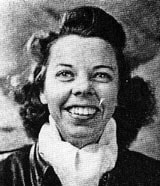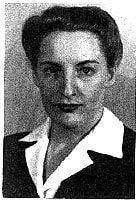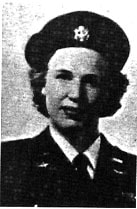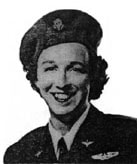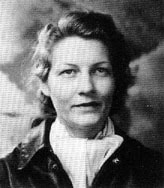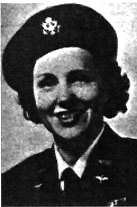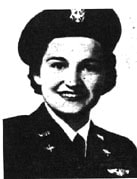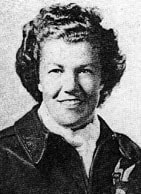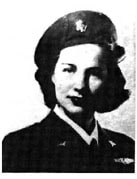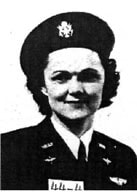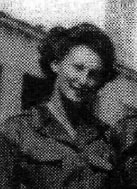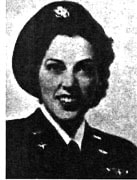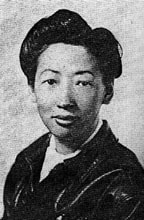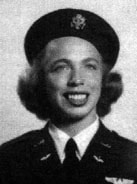Women Airforce Service Pilots
Killed in Service (Part 2)
Killed in Service (Part 2)
Page available since 10/26/97 - last updated 4/14/2023
Thirty-eight women pilots sacrificed their lives in support of WWII.
| The above table was taken from appendix Q of "On Final Approach" by Byrd Howell Granger, Class of 43-1. This book also provided much of the information presented below. Please note that some of the dates shown in the table are incorrect. |
| The follwing information and the information in Part 1 provides a little more on the life and death of the of these courageous women. |
|
Dorothy Mae "Dottie" Nichols ??? to June 11, 1944 Dorothy reported to the 6th Ferrying Group at Long Beach Army Air Base after basic training. After a year of flying lighter aircraft, she graduated from pursuit school on May 15, 1944. She ferried P-47s, P-40s, and P-39s for about a year. While flying a P-39 from Buffalo New York back to Great Falls Montana, they had to refuel in Bismark, ND. Dorothy reported problems with the engine and the carburettor was replaced. A substitute part had to be used due to lack of parts. At the end of the runway, Dottie checked out the plane. It was not running properly and others in line to take-off moved aside to let her return to the flight line, but she went on. Shortly after take-off, the engine quit. The plane crashed and went up in flames. An accident investigator reported that Dottie was killed by the control stick going through her forehead before the flames engulfed the plane. Jary Johnson, a WASP flying another P-39 with Dorothy, escorted Dorothy's body back to Los Angles for the funeral, which was attended by both Nancy Love and Jackie Cochran. Prior to joining the WASP Dottie, had graduated from UCLA with a Master of Arts degree. She became a professor of history at Louisiana State where she also got her pilot's license. She took a leave of absence after WWII started and joined the WASP program on December 15, 1942. |
|
Marjorie Doris Edwards September 28, 1918 to June 13, 1944 Marjorie was just weeks away from graduation from training at Sweetwater which was scheduled for August 4, 1944. She was on a long cross country navigation training exercise in an old AT-6. Smoke started billowing from the engine. She thinks it's not that bad and waits. But she was losing altitude. She finally decides to bail out. She pulls the D-ring, but it is too late. The parachute does not have time to open. Marhorie was born in Fullerton, California, grew up in Anaheim on the families orange ranch. She had a brother and sister. She graduated from Santa Barbara State College and taught for three years before joining the WASP. She had learned to fly in 1943. Today Disneyland's "Small World" occupies the land where Marjorie grew up. |
|
Gleanna Roberts January 11, 1919 to June 20, 1944 Gleanna was out with several in her class, 44-9, training all around Avenger field. She was north of Lorraine, Texas, and working at low altitude. During a steep downwind turn, the PT-17 stalled. She was too low to recover and crashed. Gleanna was born in Sharon Township, Iowa, grew up on a farm near Iowa City, and graduated from the University of of Iowa with a degree in journalism. She worked as a reporter for the Cedar Rapids Tribune and Moline Dispatch. She loved ice skating, photography, and swimming. She took flight training at Moline Airport and with 65 hours of flight joined the WASP program. Many of her classmates and instructors collected funds and established a memorial at U of I in her name. |
|
Lea Ola McDonald October 12, 1921 to June 21, 1944 After graduating from basic training on April 15, 1944, Lea reported to Biggs Army Air Field, in El Paso, Texas. She died during a practice flight in an A-24. My mother , who was stationed at Biggs also, remembers that this may have been her first flight in this plane and lack of experience could have been a contributing factor to the crash. My mother also remembers that Lea crashed during landing. Lea was born in Hollywood, Arkansas, but moved to a farm near Seagraves, Texas, where she grew up with her brother H.B. She spent a couple of years at Wayland Baptist College and learned to fly in the CPT program. She moved to Canyon, Texas, to attend West Texas State College for a while then moved to California to work in a Douglas aircraft factory. From here she learned of the WASP. She is survived by a niece and great niece in Texas. |
|
Bonnie Jean (Alloway) Welz June 22, 1918 to June 29, 1944 The most interesting account related to Bonnie's death was an e-mail I received from Mr. Robert C. Staggs . The crash occurred on the ranch owned by his brother and he witnessed the remnants of the crash as they were being hauled away. Bonnie was born in Bridgeport, Washington, and grew up in Inglewood, California. She was married to Carl Welz and worked for central casting in Hollywood. She learned to fly at Coalinga, California, and also flew in Culver City and Olancha, California. She was quite petite and had to gain weight to join the WASP. After completing basic training on October 9, 1943, she reported to Dodge City Army Air Base in Kansas, where she received advanced training in the B-26. From here, she reported to Harlingen Army Air Field, where she towed targets for the Flexible Gunnery School. Read the Army Air Force accident report. |
|
Susan Parker Clarke ??, 1918 to July 4, 1944 Susan reported to New Castle Army Air Base in Wilminton, Delaware, after graduating from basic on March 11, 1944. From here she was sent to the 33rd Ferring Group, Fairfax Field, in Kansas City, Missouri. She died while ferring a BT-13 when it crashed near Columbia, South Carolina. Those who saw the crash reported nothing unusual preceded the crash. There was speculation about carbon monoxide in the cockpit but that could not be substantiated. Susan grew up in Cooperstown, New York, with four sisters and two brothers. In 1940, Susan and her bother Hyde learned to fly. From here it was natural to join the WASP. |
|
Paula R. Loop August 25, 1916 to July 7, 1944 Romulus Army Air Base was Paula's first duty station after graduation from basic on May 28, 1943. From here, she reported to the 33rd Flight Group at Fairfax Field, Kansas City, Missouri. During delivery of 3 BT-13s, Paula and 2 other pilots were killed. There were strong winds with severe gusts about 30 miles from Medford, Oregon. Paula was probably caught in a strong mountain slope downwind that took her into the trees where her plane burned. Paula was born in Wakita, Oklahoma. She attended Oklahoma College for Women and Oklahoma A&M where she worked on a Master's Degree. While working as a secretary in Ponca City, she learned to fly in July of 1940. She then served as a Link Trainer Instructor at Darr School for British cadets in 1942 just before joining the WASP for basic training in Houston, Texas. On April 14, 1980, at Tinker Air Force Base in Oklahoma City, a dormitory was dedicated to the memory of Paula. |
|
Bettie Mae Scott July 26, 1921 to July 8, 1944 Bettie graduated from basic on April 15, 1944, and reported to Waco Army Air Field, Waco, Texas, where she was test pilot. She was checking a BT-13. She looked over the Form 1-A from the mechanic which was the only indication as to the planes flight worthiness. At the end of the runway, she checks the functioning of all the control surfaces and the engine gauges. However, after leaving the ground the plane is in a steep attitude, too steep. At about 100 feet, the plane stalls, turns over, and crashes on its back killing Bettie instantly. An investigation revealed there was mechanical problem with the tail assembly that caused the crash. Bettie was born in Monrovia, California, where her two brothers are still living. She learned to fly at Blythe, California, and earned both a private and instrument rating. At the time of the accident, Bettie was engaged to Lt. Frank Cramer, also stationed at Waco and they were to be married later in July. Her home town shut down during her funeral. Her father was the Chief of Police and her pallbearers were all from the police department. Members of the fire department served as honorary pallbearers. |
|
Beverly Jean Moses December 21, 1923 to July 18, 1944 On June 27, 1944 Beverly graduated from basic training at Avenger Field, Sweetwater, Texas. Her orders took her to Las Vegas Army Air Field, Nevada. Based on the flip of a coin between Beverly and Mildred Taylor, Beverely won the copilot position for an instrument training flight with four others in an AT-11. The pilot was Lt. Frank Smith. During the training mission, the flight was redirected to search for a downed parachute near Mt. Charleston. Later that day, Midred reported back from her mission in a B-17 and couldn't find Beverely. Maybe she went on a night mission? Mildred began checking around but no one knew where the AT-11 was. It was now midnight. A search was started early the next day and the plane was found pancaked into the side of a mountain. The plane was mostly intact, but the center section was burned and all 6 personnel were killed. Beverly was born in Des Moines, Iowa, along with two brothers and two sisters. When she was 17, her mother died and she had to care for the younger children. After attending business school, she got a secretarial job a Solar Aircraft Company. While working there, she took flying lessons and joined the Civil Air Patrol. |
|
Mary P. Hartson January 11, 1917 to August 14, 1944 Staff Sergeant Orville Eitzen joined Mary for a test flight of a BT-13 to check the radio equipment. The weather was fair but about 15 miles north of Perrin Army Air Base near Sherman, Texas, they spun in. The cockpit was open and their seatbelts were undone indicating they were trying to get out, but they were too late. Later there were some men, especially those not working directly with the WASPs, who blamed Mary for the accident. Mary was born in Portland, Oregon, where she grew up with two brothers, Kent and Henry. After graduating from Washington High School she moved to Washington, D.C. to work for the Social Security Department. While working there she also learned to fly. |
|
Alice E. Lovejoy August 14, 1915 to September 13, 1944 Alice reported to the 3rd Ferrying Group, Romulus Army Air Base, in Romulus, Michigan after graduation from basic training in Sweetwater. After spending a year there, she was sent to Pursuit School in Brownsville, Texas. While flying in formation with another AT-6 there was a mid-air collision. Alice's instructor was able to bail out. Alice was born in Scarsdale, New York, as the middle of three sisters. After high school she went to work at Piper Aircraft in Pennsylvania. She was one of eighteen women from Piper to join the WASPs and one of five to go to Pursuit school. Alice had an aunt named Polly Lovejoy. Polly is Alan Shepard's sister. |
|
Marie Michell [Robinson] May 23, 1924 to October 2, 1944 Marie graduated from Sweetwater and was initially stationed at Love Field, Dallas, Texas, with the 5th Ferrying Group. While there, she met Capt. H. C. Robinson and they were married two weeks prior to the accident. Marie was transferred to Victorville Army Air Base, Victorville, California for additional training on the B-25, the Mitchell Bomber. On her final flight, she was the copilot. The pilot, an enlisted crew member, and Marie were all killed after the plane reportedly went into a flat spin, a spin that is very difficult to get out of. Marie was born in Michigan and grew up in the Chicago area. She went to National Park Junior College in Washington, D.C., where she also learned to fly and get her private pilot license. After graduation from college, she returned to Chicago went to work as a Link Trainer Instructor where she added more hours to her flight log before joining the WASP. Recent news about personal items recovered from the crash site. The items were donated to the Women's Memorial Foundation by her brother. Marie's niece, Cheryl Marie Michell, arranged to honor her aunt on Monday, May 27, 2013, at White Chapel Cemetery in Troy, Michigan. More here. |
|
Peggy Wilson [Martin] February 8, 1912 to October 3, 1944 Peggy started her first assignment at Gardner Army Air Base in Taft, California. From here, she went to Marana Army Air Field in Marana, Arizona, where some of the BT-13s were maintained. It was during a test flight and just after a sluggish take-off that the engine lost all its oil. The rule was to land straight ahead when there is trouble during take-off, but that would have put her down in the tall, heavy saguaro cactus so she tried to turn and land. The plane was going too slow, eventually stalled, and dove into the ground. Marie survived the crash but died as the ambulance arrived at the base hospital. Peggy was born in Seattle Washington, but she grew up in the Long Beach, California, area. Her only brother, Willard W. Wilson, died in 1962. |
|
Marjorie Laverne Davis ??, 1923 to October 16, 1944 Marjorie and the rest of her class departed on a 2,000 mile cross country flight. Their planned destination was Courtland Army Air Field in Courtland, Alabama, near the northern boarder and about 20 miles west of Decatur. By night fall, all had landed except Marjorie. However, 90 or so miles to the west in a town called Walnut, Mississippi, the local residents were hurrying to the local landing strip with their cars to provide light for a low flying plane. Here it comes gliding down slowly, ready to flare and land. Then suddenly the plane flips and crashes. The lowered wheels had snagged on wires at the end of the landing strip. Upon her death it seemed obvious that she had joined against the wishes of her family. Their feelings were so strong that they initially would have nothing to do with the funeral in Inglewood, California. The arrangements were all handled by her escort, Hallie Stires. They finally showed up at the funeral home and demanded to see their daughter but the coffin is sealed. After some 'discussion', the coffin was opened. They left without saying anything. Not much is known about Marjorie. Muriel Rath Reynolds of 44-7 recalls that Margie learned to fly during the summer of 1943 at Reno Sky Ranch in Sparks, Nevada. Margie and two other women shared a room and expenses while they learned to fly. Muriel remembers that Marjie once said she knew how to fly before she knew how to drive. |
|
Jeanne Lewellen [Norbeck] November 14, 1912 to October 16, 1944 The coin is tossed. Jeanne wins and gets to check out the next BT-13. Marybelle Lyall will have to wait for the next plane to test. The Form 1-A reports that the 'heavy' left wing is in rig now. Jeanne takes off and puts the plane through its paces. She decides to return to the field. She slows the plane as she enters the landing pattern. Then without warning the left wing drops and the plane flips over and spins into the ground. There was no way to recover at the low altitude for landing. As with all WASP deaths, there was no money, no military escort, and no flag for the coffin. Everyone chips in to cover the expenses and an officer escorts her home. Jeanne was born in Columbus, Indiana, and grew up there with her brother and sister. She started flying while in highschool. In 1933 she graduated from Washington State College with a B. A. in English. Jeanne and her husband were in Honolulu when Pearl Harbor was bombed. She was an honors student and Group Commander for her WASP training class. There is an exhibit honoring her at the Atterbury-Bakalar Air Museum in Columbus, Indiana. |
|
Gertrude Vreeland Tompkins [Silver] October 16, 1912 to October 26, 1944 Gertrude became missing in service during her last flight in a P-51 fighter plane. She departed from Los Angeles, California, and flew east, but never made it to her destination. A massive air search was launched, but no trace of her or her plane was ever found. Even as late as June 8, 1994, the HQ for Air Force Safety Agency reported that no wreckage of this accident has been located . Gertrude was born in Jersey City, New Jersey and attended private school in Summit, New Jersey. She also attended the Pennsylvania School of Horticulture and travelled extensively to study the gardens of the world. She learned to fly at a Long Island, New York airport. While in the WASPs she married Henry M. Silver, a Hollywood producer. Family and friends close to finding wreckage . |
|
Hazel Ying Lee August ??, 1912 to November 23, 1944 It was Thanksgiving week. Many personnel at Great Falls AFB, Montana, were on leave. However, there were so many P-63s in the air, on the ground, and in all possible modes of landing, taking off, flying, and taxiing, that the tower controllers had trouble identifying and talking to the planes. There was also a jeep on the ground waiting to cross the runway. While waiting in the jeep, the officer and female driver noticed two planes on final approach. "Ah Ying" was below another P-63 being flown by Lt. Charles 'Jeff' Russell. Jeff's radio was out and couldn't be fixed at his previous stop. The tower finally sees the pending collision. They are not sure which one they have radio contact with. Finally, the operator yells, "Pull up! Pull up!!". Ah Ying responds and pulls up into the belly of the other plane. They crash in one flaming mass. Jeff scrambles out but Ah Ying is unconscious. Rescue and fire crews arrive and pull Ah Ying from the wreckage and take her to the base hospital. They remove her smouldering dark blue down filled flight suit to find she is "badly burned." The hospital staff do what they can to make her comfortable, but the burns are so severe she dies after 48 hours. She was conscious the whole time and never complained. WASP Pat Dickerson escorted Hazel back to Romulus, Michigan, her home base. It took over a year to find any family members to claim her body. Hazel was one of nine children and was a first generation Chinese American. After highschool, she learned to fly at Swan Island, Portland. She also trained in aerobatics. She went to China during the Sino-Japan war but was not allowed to fly. When she returned to the U. S., she moved to New York and supported the Chinese in procurement of materials for China. After completing basic WASP training on August 7, 1943, she reported to the 3rd Ferring Group in Romulus, Michigan. |
|
Katherine "Kay" Applegate [Dussaq] ??, 1905 to November 26, 1944 Kay was the Executive for the Training Command and at this juncture was surveying for employment opportunities for the WASPs which were being disbanded on the 20th of next month. She had just completed a meeting with Jackie Cochran and the CAA in Washington, D. C., and was preparing to fly to Cincinnati to meet with Nancy Love. While in D. C., she was able to get the CAA to grant commercial licenses to all active duty WASP. The weather was a slight problem, but there was much to do and she figured to go around it. Just outside of New Castle, Ohio, the engine on her AT-6 quit. She was not wearing her seatbelt and on impact her head hit the control stick. Kay was born in Dayton, Washington, along with two brothers and two sisters. She attended Washington State College, Stanton, and Whitman College in California. She had a laboratory in Chicago that specialized in identifying fraudulent documents. She participated in hundreds of cases across the country as an expert witness. Her planning and work during the final months of her life led to a WASP newsletter and a basis for a post inactivation organization, Order of Fifinella. |
|
Mary Louise Webster June 30, 1919 to December 9, 1944 Mary graduated from basic training on October 16, 1944, and was then assigned to Frederick Army Air Field, Frederick, Oklahoma. The December weather in Oklahoma was a factor. Mary and Sgt. Melvin Clark were passengers in a UC-78 flying from Frederick in southwest of Oklahoma to Tulsa in the northeast part of the state. During the flight they ran into the cold front moving through the state. The pilot, Lt. George W. Crowe, climbs to 9,000 feet to stay above the clouds. Near Tulsa he contacts traffic control and asks for permission to descend. He begins the descent, but later requests to climb back up. Traffic controls agrees. But it was too late, the plane's wings iced over and it went into a steep dive. All were killed. Mary was born in Ellensburg, Washington, the eighth of nine children. She attended Central Washington State College. Her two older brothers, who were in the military inspired her to investigate women's roles in the military. She worked on her pilot license and required hours at Ellensburg Field and in Yakima, Washington, and was accepted into the WASPs. Mary's name is inscribed on a War Memorial Plague at the Kittitas County Courthouse. She is the only woman named on this plaque. |
| See Part 1 for more on the life and death of the of these courageous women. |



